Characteristics of Resuspended Road Dust with Traffic and Atmospheric Environment in South Korea
Abstract
1. Introduction
2. Materials and Methods
2.1. Study Area
2.2. Resuspended PM10 Measuring System
- Vehicle specifications: 2016 SUV Sportage 2.02 WD, Tire Model 225/60R17.
- PM10 Sensor: The 8530 Dust-Trak Optical PM Sensor Model (TSI Company, Shoreview, MN, USA) with PM10 inlet is a portable device that can measure the concentrations of various sizes of dust particles in real time, such as PM10 and PM2.5.
- Inlet: The right tire line inlet is 175 mm above the ground and 50 mm behind the tire. The PM10 concentration (Ci) obtained from the back of the tire during movement indicates that the air velocity measured along the center of the tire was not affected significantly by the surrounding wind direction at a distance less than 100 mm from the tire [27].
- Uniform Velocity Flow Sampling Inhalation: A vacuum pump is controlled by a customized suction port to adjust the pressure of the suction port appropriately, thereby producing a pressure-free suction port, so the air flow that is being sampled has the same fluid flow as the surrounding air flow.
- Data Collection System: Laptop computers were used to collect and transmit Dust-Trak data at one-second intervals.
- Monitoring Camera: A camera capable of monitoring the inside and outside of the vehicle can be installed to visually cross-verify the measurement data in the driving section and monitor the speed observed on the vehicle’s speedometer.
2.3. AP-42 Silt Loading Collection
2.4. Collecting City PM10, Meteorological Variables, and Traffic Data
3. Results and Discussion
3.1. Verification of the Real-Time Measuring System
- (1)
- We ensured that the measured concentration did not vary significantly when the vehicle stopped, and tried to calculate the range of the measured speed by comparing the concentration measured by increasing the speed as it passed the section at a constant speed.
- (2)
- If a certain measurement speed was maintained, the average Cres concentration measured in a short section and the amount of dust accumulated on the surface of the road and the concentration of the resuspended dust due to vehicle travel were quantified by the sL collected at three different locations in the section.
- (3)
- The correlation was analyzed by comparing the concentration of Cres measured by the size of sL in different sections (regions) selected by classification according to the major causes of the inflow of the expected material.
3.2. sL and Resuspended Dust on Paved Roads with Different Inflow Conditions
3.3. Relationship between Section Background Concentration of Dust and Its Resuspended PM10
3.4. Analysis of PM10 Concentration Characteristics of Resuspended Dust by Influencing Factors
- -
- Low-level type: under 7.7 μg/m3.
- -
- Low- to middle-level type: 7.7 to 12.7 μg/m3.
- -
- Middle- to high-level type: 12.7 to 15.6 μg/m3.
- -
- High-level type: 15.6 to 29 μg/m3.
- -
- Bad-level type: over 29 μg/m3 and the number of measurements by Cres grade was the same as Figure 9.
3.5. Characteristics of Ci, CBg Resuspended Dust by Lane Traffic Level by Measurement Section through Statistical Probability Comparison
4. Conclusions
- -
- A significant correlation coefficient between Bg and R > 0.3 was derived from time after rain (R = 0.41) and visibility (R = −0.35), CBg by section was time after rain (R = 0.35 to 0.50) and visibility (R = −0.60 to –0.33), and time after rain and visibility were found to have similar characteristics to Bg and CBg.
- -
- A lane traffic level type for whole data was compared by dividing the upper distribution of the lower quartile (25th) value into a high-level type, median to 75th value distribution grade into middle to high-level type, and the 25th to median value range distribution grade into low-level type.
- -
- Higher Cres values were observed consistently in sections with a relatively high frequency of occurrence of high levels of lane traffic among sections traveling in the same direction on roads divided by location.
- -
- The lowest average CBg (45.0 μg/m3) and average Ci (56.7 μg/m3) concentrations were measured in Section E, where low levels of lane traffic were observed the most, i.e., 22 times.
- -
- Among the data samples classified by lane traffic level type, the order in which the Cres mean was observed and found to be large was lane traffic low to middle level (15.3 μg/m3) > lane traffic middle to high level (12.7 μg/m3) > lane traffic high level (11.9 μg/m3) > lane traffic low level (10.1 μg/m3).
- -
- The average level of lane traffic level CBg was observed to be relatively high in the order of lane traffic low to middle level (45.0 μg/m3) < lane traffic low level (47.9 μg/m3) < lane traffic middle to high level (49.6 μg/m3) < lane traffic high level (56.7 μg/m3). The average level of Ci was observed in the order of lane traffic low level (47.9 μg/m3) < lane traffic low to middle level (49.6 μg/m3) < lane traffic middle to high level (62.3 μg/m3) < lane traffic high level (68.6 μg/m3).
- -
- The overall pollution level of the road may have increased as lane traffic level increased. However, when the traffic volume increased, the relative road atmospheric pollution also increased, so the Cres level did not differ significantly.
Author Contributions
Funding
Institutional Review Board Statement
Informed Consent Statement
Data Availability Statement
Acknowledgments
Conflicts of Interest
References
- Pope, C.A.; Thun, M.J.; Namboodiri, M.M.; Dockery, D.W.; Evans, J.S.; Speizer, F.E.; Heath, C.W. Particulate air pollution as a predictor of mortality in a prospective study of US adults. Am. J. Respir. Crit. Care Med. 1995, 1513, 669–674. [Google Scholar] [CrossRef] [PubMed]
- Askariyeh, M.H.; Venugopal, M.; Khreis, H.; Birt, A.; Zietsman, J. Near-road traffic-related air pollution: Resuspended PM2.5 from highways and arterials. Int. J. Environ. Res. Public Health 2020, 17, 2851. [Google Scholar] [CrossRef] [PubMed]
- Lewis, A.; Moller, S.J.; Carslaw, D. Non-Exhaust Emissions from Road Traffic. 2019. Available online: https://eprints.whit-erose.ac.uk/156628/ (accessed on 27 July 2022).
- Rienda, I.C.; Alves, C.A. Road dust resuspension: A review. Atmos. Res. 2021, 261, 105740. [Google Scholar] [CrossRef]
- Penkała, M.; Ogrodnik, P.; Rogula-Kozłowska, W. Particulate matter from the road surface abrasion as a problem of non-exhaust emission control. Environments 2018, 5, 9. [Google Scholar] [CrossRef]
- Amato, F.; Alastuey, A.; De La Rosa, J.; Gonzalez Castanedo, Y.; Sánchez de la Campa, A.M.; Pandolfi, M.; Lozano, A.; Contreras González, J.; Querol, X. Trends of road dust emissions contributions on ambient air particulate levels at rural, urban and industrial sites in southern Spain. Atmos. Chem. Phys. 2014, 14, 3533–3544. [Google Scholar] [CrossRef]
- Amato, F.; Cassee, F.R.; van der Gon, H.A.; Gehrig, R.; Gustafsson, M.; Hafner, W.; Harrison, R.M.; Jozwicka, M.; Kelly, F.J.; Moreno, T.; et al. Urban air quality: The challenge of traffic non-exhaust emissions. J. Hazard. Mater. 2014, 275, 31–36. [Google Scholar] [CrossRef]
- Matthias, V.; Arndt, J.A.; Aulinger, A.; Bieser, J.; Denier van der Gon, H.; Kranenburg, R.; Kuenen, J.; Neumann, D.; Pouliot, G.; Quante, M. Modeling emissions for three-dumensional atmospheric chemistry transport models. J. Air Waste Manag. Assoc. 2018, 68, 763–800. [Google Scholar] [CrossRef] [PubMed]
- Choi, Y.; Kim, Y.; Lee, H. A study on road cleaning to reduce resuspension of road dust. Seoul Inst. Policy Res. 2018, 1–135. Available online: http://lib.seoul.go.kr/oak/handle/201302/20733 (accessed on 27 July 2022).
- Kakosimos, K.E.; Hertel, O.; Ketzel, M.; Berkowicz, R. Operational Street Pollution Model (OSPM)—A review of performed application and validation studies, and future prospects. Environ. Chem. 2010, 7, 485–503. [Google Scholar] [CrossRef]
- Padoan, E.; Ajmone-Marsan, F.; Querol, X.; Amato, F. An empirical model to predict road dust emissions based on pavement and traffic characteristics. Environ. Pollut. 2018, 237, 713–720. [Google Scholar] [CrossRef]
- Kuhns, H.; Etyemezian, V.; Landwehr, D.; MacDougall, C.; Pitchford, M.; Green, M. Testing re-entrained aerosol kinetic emissions from roads: A new approach to infer silt loading on roadways. Atmos. Environ. 2001, 35, 2815–2825. [Google Scholar] [CrossRef]
- Han, S.; Youn, J.S.; Jung, Y.W. Characterization of PM10 and PM2.5 source profiles for resuspended road dust collected using mobile sampling methodology. Atmos. Environ. 2011, 45, 3343–3351. [Google Scholar] [CrossRef]
- Li, D.; Chen, J.; Zhang, Y.; Gao, Z.; Ying, N.; Gao, J.; Zhang, K.; Zhu, S. Dust emissions from urban roads using the AP-42 and TRAKER methods: A case study. Atmos. Pollut. Res. 2021, 12, 101051. [Google Scholar] [CrossRef]
- Amato, F.; Pandolfi, M.; Viana, M.; Querol, X.; Alastuey, A.; Moreno, T. Spatial and chemical patterns of PM10 in road dust deposited in urban environment. Atmos. Environ. 2009, 43, 1650–1659. [Google Scholar] [CrossRef]
- Amato, F.; Pandolfi, M.; Escrig, A.; Querol, X.; Alastuey, A.; Pey, J.; Pérez, N.; Hopke, P.K. Quantifying road dust resuspension in urban environment by multilinear engine: A comparison with PMF2. Atmos. Environ. 2009, 43, 2770–2780. [Google Scholar] [CrossRef]
- Hussein, T.; Johansson, C.; Karlsson, H.; Hansson, H.C. Factors affecting non-tailpipe aerosol particle emissions from paved roads: On-road measurements in Stockholm, Sweden. Atmos. Environ. 2008, 42, 688–702. [Google Scholar] [CrossRef]
- Fan, S.; Tian, G.; Li, G.; Huang, Y.; Qin, J.; Cheng, S. Road fugitive dust emission characteristics in Beijing during Olympics Game 2008 in Beijing, China. Atmos. Environ. 2009, 43, 6003–6010. [Google Scholar]
- Zhu, D.; Kuhns, H.D.; Brown, S.; Gillies, J.A.; Etyemezian, V.; Gertler, A.W. Fugitive dust emissions from paved road travel in the Lake Tahoe basin. J. Air Waste Manag. Assoc. 2009, 59, 1219–1229. [Google Scholar] [CrossRef]
- Kauhaniemi, M.; Stojiljkovic, A.; Pirjola, L.; Karppinen, A.; Harkonen, J.; Kupiainen, K.; Kangas, L.; Aarnio, M.A.; Omstedt, G.; Denby, B.R.; et al. Comparison of the predictions of two road dust emission models with the measurements of a mobile van. Atmos. Chem. Phys. 2014, 14, 9155–9169. [Google Scholar] [CrossRef]
- Kwak, J.; Lee, S.; Lee, S. On-road and laboratory investigations on non-exhaust ultrafine particles from the interaction between the tire and road pavement under braking conditions. Atmos. Environ. 2014, 97, 195–205. [Google Scholar] [CrossRef]
- Zhang, W.; Ji, Y.; Zhang, S.; Zhang, L.; Wang, S. Determination of silt loading distribution characteristics using a rapid silt loading testing system in Tianjin, China. Aerosol Air Qual. Res. 2017, 17, 2129–2138. [Google Scholar] [CrossRef]
- U.S. Environmental Protection Agency. Emission Factor Documentation for AP-42, Section 13.2.1 Paved Roads. EPA Contact No. 68-D0-0123, Work Assignment No.44 MRI Project No. 9712-44(1993). Available online: https://www3.epa.gov/ttn/chief/ap42/ch13/bgdocs/b13s0201.pdf (accessed on 27 July 2022).
- Askariyeh, M.H.; Zietsman, J.; Autenrieth, R. Traffic contribution to PM2.5 increment in the near-road environment. Atmos. Environ. 2020, 224, 117113. [Google Scholar] [CrossRef]
- Jung, Y.W.; Han, S.H.; Won, K.H.; Jang, K.W.; Hong, J.H. Present status of emission estimation methods of resuspended dusts from paved roads. J. Korean Soc. Environ. Eng. 2006, 28, 1126–1132. [Google Scholar]
- Perera, I.E.; Litton, C.D. Quantification of optical and physical properties of combustion-generated carbonaceous aerosols (<PM2.5) using analytical and microscopic techniques. Fire Technol. 2015, 51, 247–269. [Google Scholar] [CrossRef] [PubMed][Green Version]
- Zhu, D.; Kuhns, H.D.; Gillies, J.A.; Etyemezian, V.; Gertler, A.W.; Brown, S. Inferring deposition velocities from changes in aerosol size distributions downwind of a roadway. Atmos. Environ. 2011, 45, 957–966. [Google Scholar] [CrossRef]
- U.S. Environmental Protection Agency. Environmental Protection Agency Compilation of Air Pollution Emission Factors, AP-42, 5th ed.; U.S. Environmental Protection Agency: Washington, DC, USA, 2003; Volume I: Stationary Point and Area Sources, Section 13.2.1 Paved Roads.
- Amato, F.; Schaap, M.; van der Gon, H.A.D.; Pandolfi, M.; Alastuey, A.; Keuken, M.; Querol, X. Effect of rain events on the mobility of road dust load in two Dutch and Spanish roads. Atmos. Environ. 2012, 62, 352–358. [Google Scholar] [CrossRef]
- Lundberg, J. Non-exhaust PM10 and road dust. Dr. Diss. KTH R. Inst. Technol. 2018. Available online: https://www.diva-portal.org/smash/get/diva2:1179589/FULLTEXT02 (accessed on 27 July 2022).
- Kuhns, H.; Gillies, J.; Etyemezian, V.; Dubois, D.; Ahonen, S.; Nikolic, D.; Durham, C. Spatial Variability of Unpaved Road Dust PM10 Emission Factors near El Paso, Texas. J. Air Waste Manag. Assoc. 2005, 55, 3–12. [Google Scholar] [CrossRef] [PubMed]
- Lin, S.; Liu, Y.; Chen, H.; Wu, S.; Michalaki, V.; Proctor, P.; Rowley, G. Impact of change in traffic flow on vehicle non-exhaust PM2.5 and PM10 emissions: A case study of M25 motorway, UK. Chemosphere 2022, 303, 135069. [Google Scholar] [CrossRef]
- Sahanavin, N.; Prueksasit, T.; Tantrakarnapa, K. Relationship between PM10 and PM2.5 levels in high-traffic area determined using path analysis and linear regression. J. Environ. Sci. 2018, 69, 105–114. [Google Scholar] [CrossRef]
- Denby, B.R.; Sundvor, I.; Johansson, C.; Pirjola, L.; Ketzel, M.; Norman, M.; Kupiainen, K.; Gustafsson, M.; Blomqvist, G.; Omstedt, G. A coupled road dust and surface moisture model to predict non-exhaust road traffic induced particle emissions (NORTRIP). Part 1: Road dust loading and suspension modelling. Atmos. Environ. 2013, 77, 283–300. [Google Scholar] [CrossRef]
- Han, S.; Won, K.; Jang, K.; Son, Y.; Kim, J.; Hong, J.; Jung, Y. Development and Application of Real-time Measurement System of Silt Loading for Estimating the Emission Factor of Resuspended Dust from Paved Road. J. Korean Soc. Atmos. Environ. 2007, 23, 596–611. [Google Scholar] [CrossRef]
- Pope, C.A.; Burnett, R.T.; Thun, M.J.; Calle, E.E.; Krewski, D.; Ito, K.; Thurston, G.D. Lung cancer, cardiopulmonary mortality, and long-term exposure to fine particulate air pollution. JAMA 2002, 287, 1132–1141. [Google Scholar] [CrossRef] [PubMed]
- Yang, W. Changes in Air Pollutant Concentrations Due to Climate Change and the Health Effect of Exposure to Particulate Matter. J. Popul. Health Stud. 2019, 269, 20–31. [Google Scholar]
- Lee, G.H. Understanding and Contrasting Yellow Dust. J. Korean Soc. Soc. Secur. 2009, 2, 18–27. [Google Scholar]
- Thorpe, A.J.; Harrison, R.M.; Boulter, P.G.; McCrae, I.S. Estimation of particle resuspension source strength on a major London Road. Atmos. Environ. 2007, 41, 8007–8020. [Google Scholar] [CrossRef]
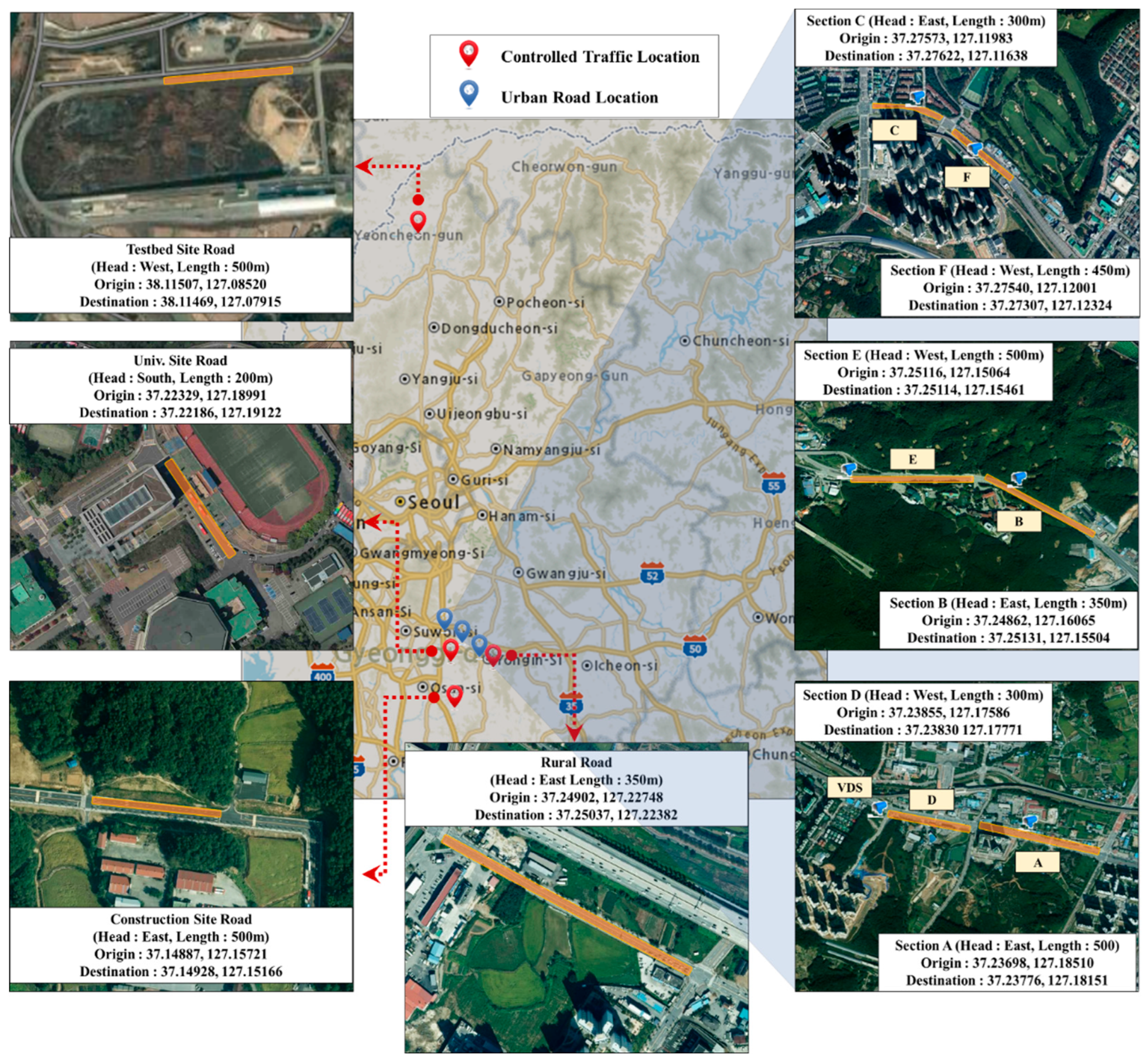
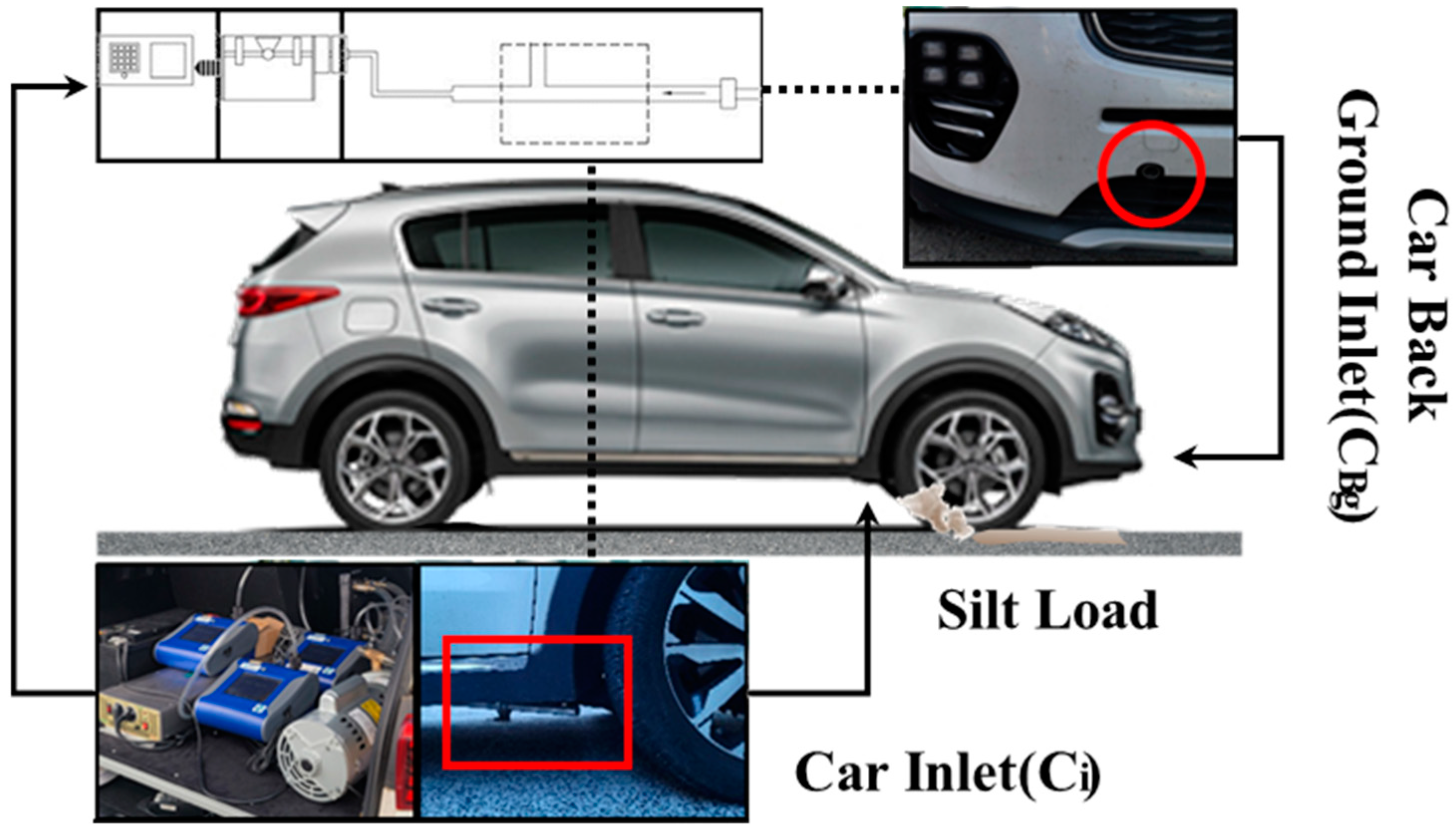
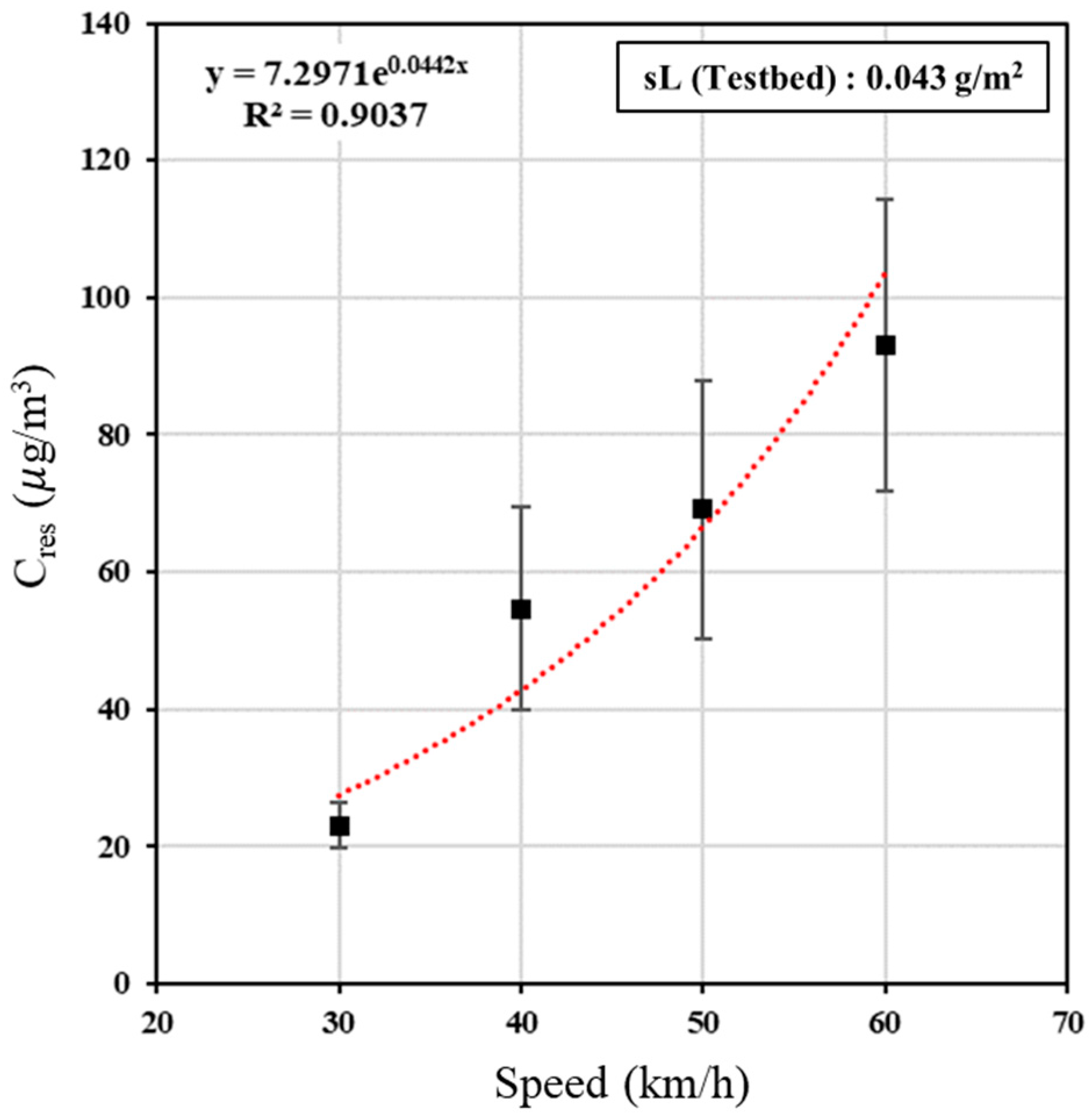

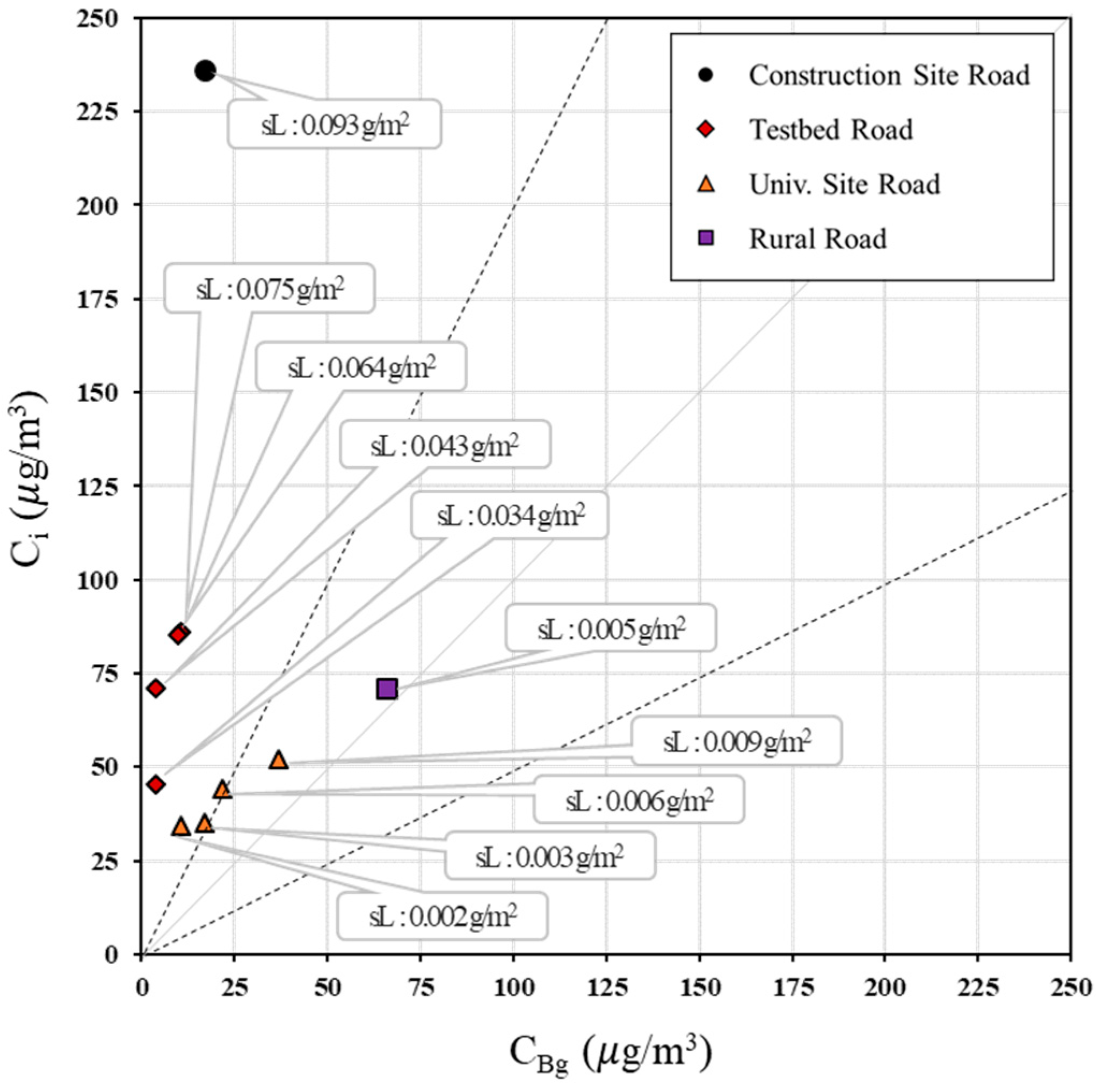


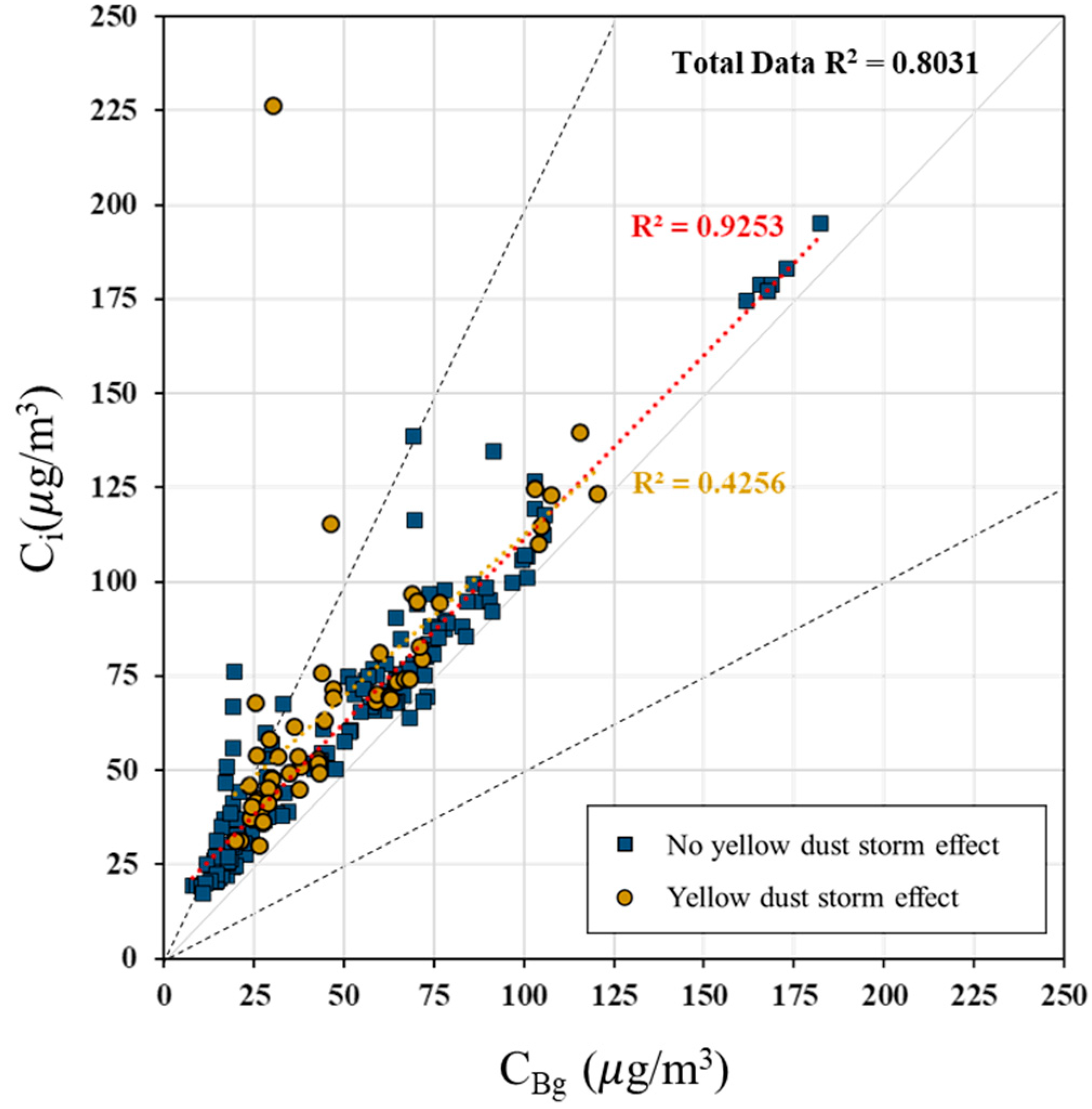

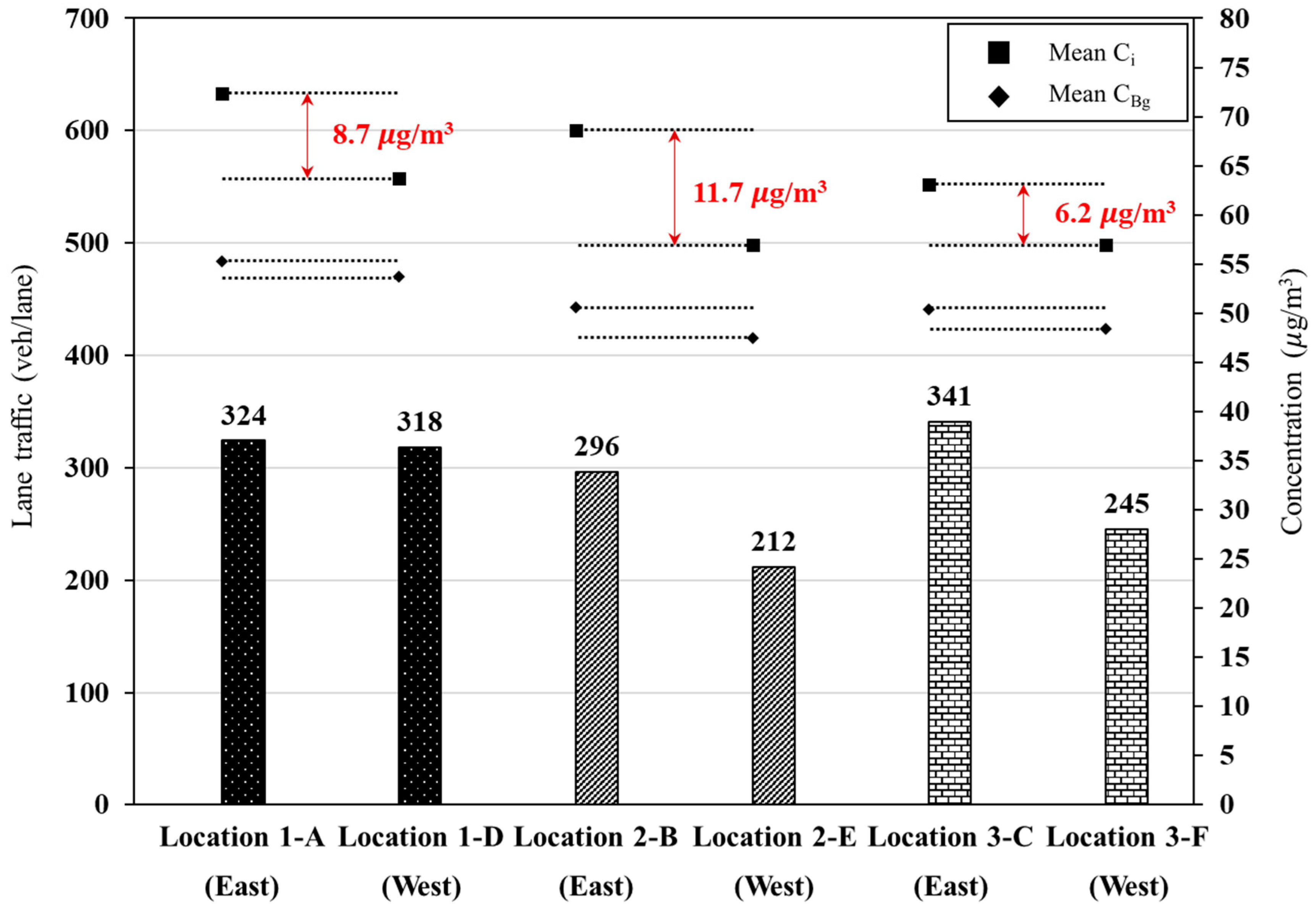
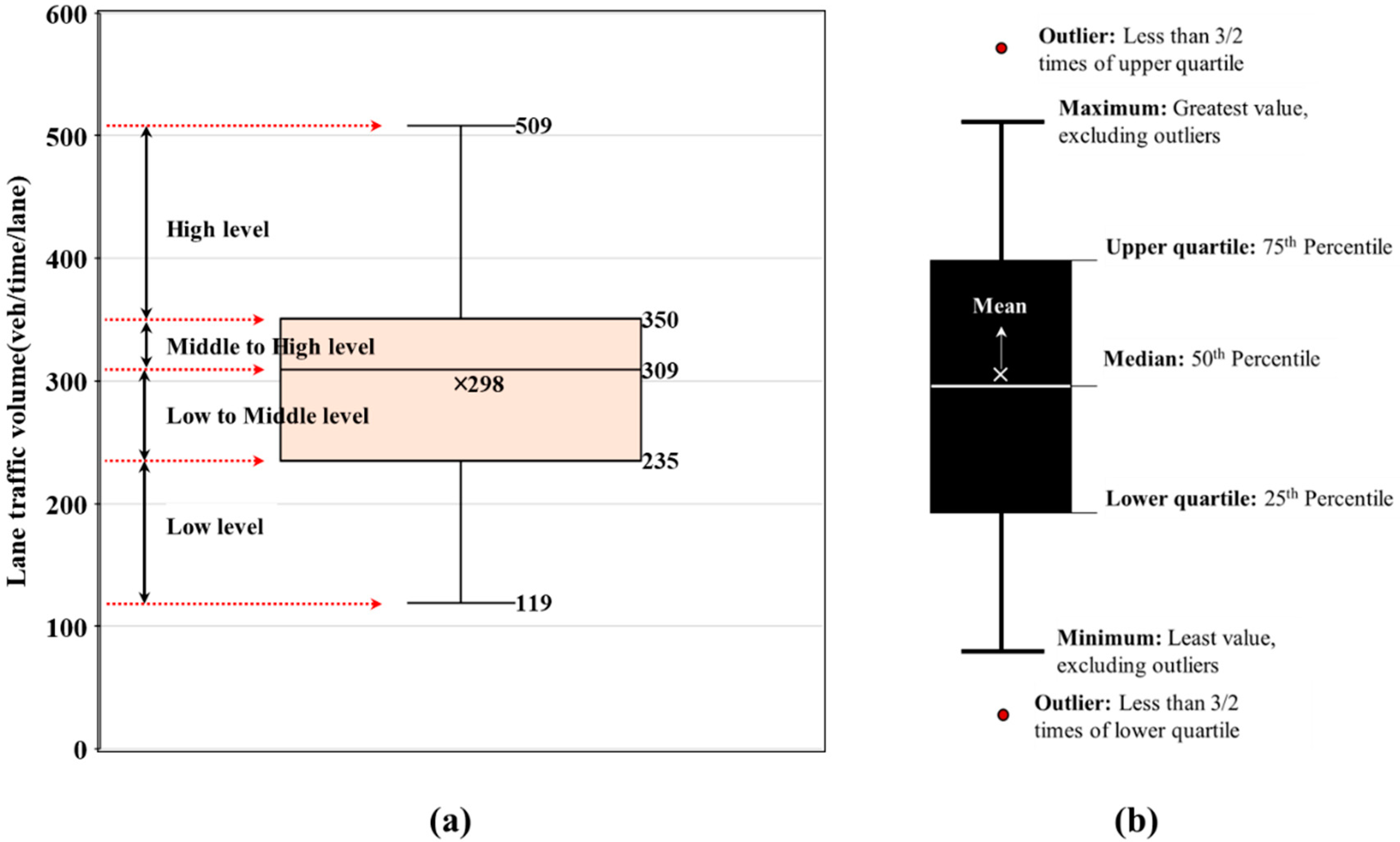

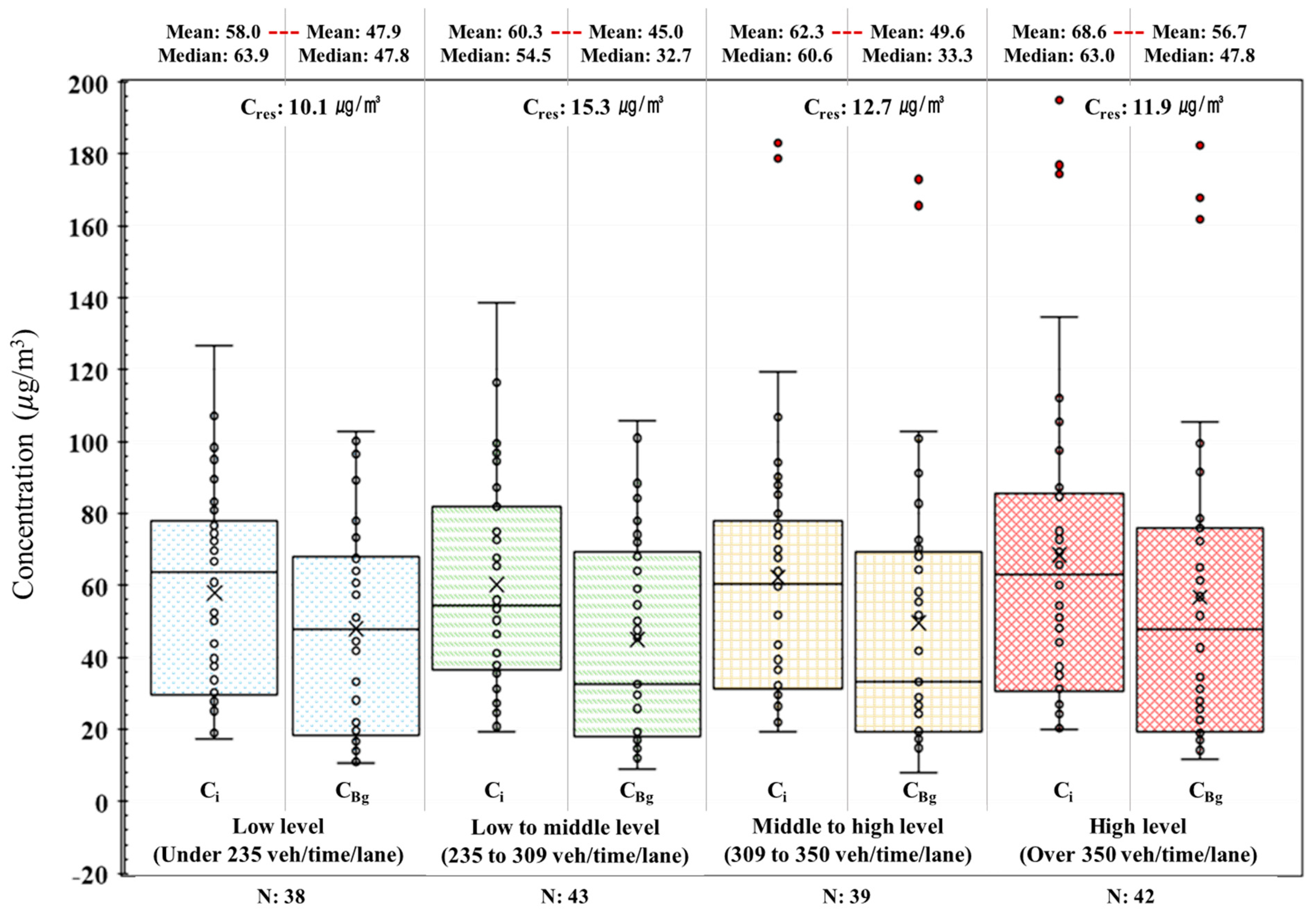
| Category | Site | Length (m) | Road Width/Condition | Distance of the Observation | |
|---|---|---|---|---|---|
| City Bg PM10 | Meteorological Variables | ||||
| Controlled Traffic | Testbed | 500 | One-lane road | With a radius of 2.5 km | With a radius of 24 km |
| Construction Site | 500 | Two-lane road | With a radius of 3.5 km | With a radius of 20 km | |
| Univ. | 200 | One-lane road | With a radius of 1.6 km | With a radius of 14.5 km | |
| Rural | 350 | Two-lane road | With a radius of 2.8 km | With a radius of 17.5 km | |
| Operating road | A | 500 | Four-lane road/ 905 (Veh/time/day) | With a radius of 8 km | With a radius of 14.5 km |
| B | 350 | Three-lane road/ 633 (Veh/time/day) | With a radius of 5 km | With a radius of 11.5 km | |
| C | 300 | Four-lane road/ 1006 (Veh/time/day) | With a radius of 1 km | With a radius of 8.2 km | |
| D | 300 | Four-lane road/ 850 (Veh/time/day) | With a radius of 8 km | With a radius of 13.2 km | |
| E | 500 | Three-lane road/ 431 (Veh/time/day) | With a radius of 5 km | With a radius of 11 km | |
| F | 450 | Four-lane road/ 697 (Veh/time/day) | With a radius of 1 km | With a radius of 8.5 km | |
| Car Speed (km/h) | Cres Mean (μg/m3) | Cres SD (μg/m3) |
|---|---|---|
| 30 | 23.0 | 3.4 |
| 40 | 54.6 | 14.8 |
| 50 | 69.1 | 18.9 |
| 60 | 93.0 | 21.3 |
| Section | sL 1 (g/m2) | sL 2 (g/m2) | sL 3 (g/m2) | Mean sL (g/m2) | Bg PM10 (μg/m3) | Mean Ci PM10 (μg/m3) | Mean CBg PM10 (μg/m3) | Mean Cres PM10 (μg/m3) | |
|---|---|---|---|---|---|---|---|---|---|
| Construction Site Road | 0.115 | 0.089 | 0.074 | 0.093 | 30 | 242 | 17 | 225 | |
| Testbed Road | Day 1 | 0.024 | 0.038 | 0.039 | 0.034 | 13 | 51 | 4 | 47 |
| Day 2 | 0.043 | 0.044 | 0.042 | 0.043 | 18 | 77 | 4 | 73 | |
| Day 3 | 0.062 | 0.068 | 0.063 | 0.064 | 26 | 93 | 11 | 81 | |
| Day 4 | 0.069 | 0.08 | 0.075 | 0.075 | 21 | 91 | 10 | 81 | |
| Univ. Site Road | Day 1 | 0.002 | 0.002 | 0.002 | 0.002 | 10 | 40 | 11 | 29 |
| Day 2 | 0.003 | 0.003 | 0.003 | 0.003 | 16 | 41 | 17 | 24 | |
| Day 3 | 0.005 | 0.005 | 0.007 | 0.006 | 23 | 50 | 22 | 28 | |
| Day 4 | 0.009 | 0.01 | 0.008 | 0.009 | 36 | 58 | 37 | 21 | |
| Rural Road | 0.007 | 0.006 | 0.003 | 0.005 | 58 | 77 | 66 | 11 | |
| Section | Cres (μg/m3) | Bg (μg/m3) |
|---|---|---|
| A | 33.1 | 103 |
| 34.4 | 39 | |
| 47.6 | 55 | |
| B | 31.4 | 15 |
| 33.5 | 55 | |
| 36.7 | 46 | |
| 46.7 | 113 | |
| 69.4 | 104 | |
| C | 56.7 | 58 |
| D | 32.6 | 55 |
| E | 29.5 | 58 |
| Independent | Correlation R-Value | |||||||||
|---|---|---|---|---|---|---|---|---|---|---|
| Ci | Bg | Lane Traffic | Gr Temp. | RH | WS | Sea Level Pressure | Visibility | Rainfall Time | ||
| Bg | 0.66 | 0.04 | −0.12 | −0.14 | −0.13 | 0.19 | −0.35 | 0.41 | ||
| Section A | CBg | 0.95 | 0.62 | −0.21 | −0.24 | 0.36 | −0.30 | 0.35 | −0.60 | 0.44 |
| Ci | 0.71 | −0.14 | −0.12 | 0.24 | −0.27 | 0.25 | −0.52 | 0.34 | ||
| Section B | CBg | 0.93 | 0.67 | 0.05 | −0.28 | 0.29 | −0.29 | 0.47 | −0.59 | 0.48 |
| Ci | 0.77 | 0.00 | −0.11 | 0.18 | −0.21 | 0.35 | −0.46 | 0.43 | ||
| Section C | CBg | 0.96 | 0.70 | −0.09 | −0.29 | 0.16 | −0.32 | 0.38 | −0.50 | 0.44 |
| Ci | 0.74 | −0.17 | −0.27 | 0.14 | −0.30 | 0.34 | −0.41 | 0.38 | ||
| Section D | CBg | 0.99 | 0.49 | 0.29 | −0.14 | 0.08 | −0.36 | 0.47 | −0.40 | 0.35 |
| Ci | 0.52 | 0.27 | −0.14 | 0.04 | −0.32 | 0.45 | −0.35 | 0.34 | ||
| Section E | CBg | 0.98 | 0.52 | 0.53 | −0.19 | 0.26 | −0.33 | 0.35 | −0.36 | 0.49 |
| Ci | 0.56 | 0.55 | −0.22 | 0.24 | −0.29 | 0.34 | −0.28 | 0.43 | ||
| Section F | CBg | 0.99 | 0.69 | 0.35 | −0.31 | 0.23 | −0.30 | 0.48 | −0.56 | 0.47 |
| Ci | 0.70 | 0.34 | −0.30 | 0.24 | −0.27 | 0.47 | −0.53 | 0.46 | ||
| Lane Traffic Level | Percentile of Data | Cres (μg/m3) | Bg (μg/m3) | Gr Temp (°C) | RH (%) | WS (m/s) | Sea Level Pressure (hPa) | Visibility (m) | Rainfall Time (Days) |
|---|---|---|---|---|---|---|---|---|---|
| High (over 350 veh/time/lane) | 75th | 14.0 | 93.0 | 19.6 | 54.0 | 4.0 | 1025.9 | 1996.3 | 7.0 |
| Mean | 11.9 | 53.2 | 15.9 | 48.1 | 3.0 | 1022.1 | 1685.2 | 5.4 | |
| Median | 9.6 | 50.0 | 13.3 | 49.5 | 3.1 | 1020.6 | 1932.0 | 4.0 | |
| 25th | 6.1 | 23.5 | 11.5 | 36.8 | 1.6 | 1019.5 | 1635.0 | 3.0 | |
| Middle to high (309 to 350 veh/time/lane) | 75th | 16.5 | 93.0 | 26.0 | 68.0 | 3.7 | 1021.6 | 1995.0 | 7.0 |
| Mean | 12.6 | 57.8 | 21.0 | 47.5 | 2.6 | 1019.6 | 1703.5 | 5.9 | |
| Median | 11.1 | 56.0 | 21.4 | 44.0 | 2.5 | 1019.5 | 1937.0 | 6.0 | |
| 25th | 7.2 | 34.0 | 13.3 | 31.0 | 1.5 | 1018.0 | 1527 | 4.0 | |
| Low to middle (235 to 309 veh/time/lane) | 75th | 20.1 | 70.0 | 24.8 | 53.0 | 3.8 | 1025.6 | 1995.0 | 6.0 |
| Mean | 15.3 | 54.0 | 19.0 | 46.1 | 2.8 | 1021.1 | 1736.0 | 4.7 | |
| Median | 10.7 | 51.0 | 19.6 | 46.0 | 2.8 | 1020.5 | 1932.0 | 4.0 | |
| 25th | 8.0 | 34.0 | 13.3 | 31.0 | 1.6 | 1018.8 | 1685.0 | 4.0 | |
| Low (under 235 veh/time/lane) | 75th | 11.6 | 61.0 | 25.5 | 68.3 | 3.8 | 1024.8 | 1986.8 | 6.0 |
| Mean | 10.1 | 54.4 | 17.0 | 53.0 | 2.6 | 1021.0 | 1588.0 | 4.8 | |
| Median | 8.9 | 51.0 | 18.7 | 52.0 | 2.5 | 1020.6 | 1895.5 | 5.0 | |
| 25th | 8.3 | 35.5 | 9.8 | 35.0 | 1.6 | 1018.0 | 913 | 3.8 |
Publisher’s Note: MDPI stays neutral with regard to jurisdictional claims in published maps and institutional affiliations. |
© 2022 by the authors. Licensee MDPI, Basel, Switzerland. This article is an open access article distributed under the terms and conditions of the Creative Commons Attribution (CC BY) license (https://creativecommons.org/licenses/by/4.0/).
Share and Cite
Hong, S.; Yoo, H.; Cho, J.; Yeon, G.; Kim, I. Characteristics of Resuspended Road Dust with Traffic and Atmospheric Environment in South Korea. Atmosphere 2022, 13, 1215. https://doi.org/10.3390/atmos13081215
Hong S, Yoo H, Cho J, Yeon G, Kim I. Characteristics of Resuspended Road Dust with Traffic and Atmospheric Environment in South Korea. Atmosphere. 2022; 13(8):1215. https://doi.org/10.3390/atmos13081215
Chicago/Turabian StyleHong, Sungjin, Hojun Yoo, Jeongyeon Cho, Gyumin Yeon, and Intai Kim. 2022. "Characteristics of Resuspended Road Dust with Traffic and Atmospheric Environment in South Korea" Atmosphere 13, no. 8: 1215. https://doi.org/10.3390/atmos13081215
APA StyleHong, S., Yoo, H., Cho, J., Yeon, G., & Kim, I. (2022). Characteristics of Resuspended Road Dust with Traffic and Atmospheric Environment in South Korea. Atmosphere, 13(8), 1215. https://doi.org/10.3390/atmos13081215






